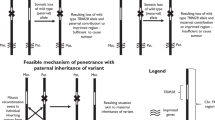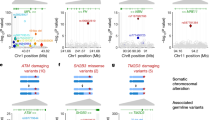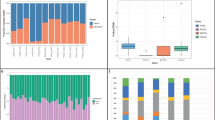Abstract
We describe the partial loss of heterozygosity (LOH) at chromosome 11 p loci in normal tissues (normal kidney and/or blood) from four of 67 Wilms' tumour patients. Autologous tumour DNA showed complete loss of the same, maternally derived, alleles. These observations indicate that the normal tissues were mosaic for cells heterozygous and homozygous for 11 p markers and that tumours subsequently developed from the homozygous cells that had undergone an 11 p somatic recombination event. We suggest that LOH for 11 p alleles is compatible with normal growth and differentiation and is significant pathologically only when accompanied by other genetic alterations.
This is a preview of subscription content, access via your institution
Access options
Subscribe to this journal
Receive 12 print issues and online access
$209.00 per year
only $17.42 per issue
Buy this article
- Purchase on Springer Link
- Instant access to full article PDF
Prices may be subject to local taxes which are calculated during checkout
Similar content being viewed by others
References
Breslow, N., Beckwith, J.B., Ciol, M. & Sharples, K. Age distribution of Wilms' tumor: report from the National Wilms' Tumor Study. Cancer Res. 48, 1653–1657 (1988).
Matsunaga, E. Genetics of Wilms' tumor. Hum. Genet. 57, 231–246 (1981).
Koufos, A. et al. Loss of alleles at loci on human chromosome 11 during genesis of Wilms' tumour. Nature 309, 170–172 (1984).
Orkin, S.H., Goldman, D.S. & Sallan, S.E. Development of homozygosity for chromosome 11p markers in Wilms' tumor. Nature 309, 172–174 (1984).
Fearon, E.R., Vogelstein, B. & Feinberg, A.P. Somatic deletion and duplication of genes on chromosome 11 in Wilms' tumours. Nature 309, 176–178 (1984).
Dao, D.D. et al. Genetic mechanisms of tumor-specific loss of 11p DNA sequences in Wilms' tumor. Am. J. hum. Genet. 41, 202–217 (1987).
Wadey, R.B. et al. Loss of heterozygosity in Wilms' tumour involves two distinct regions of chromosome 11. Oncogene 5, 901–907 (1990).
Schroeder, W.T. et al. Nonrandom loss of maternal chromosome 11 alleles in Wilms' tumors. Am. J. hum. Genet. 40, 413–420 (1987).
Call, K.M. et al. Isolation and characterization of a zinc finger polypeptide gene at the human chromosome 11 Wilms' tumor locus. Cell 60, 509–520 (1990).
Gessler, M. et al. Homozygous deletion in Wilms' tumours of a zinc-finger gene identified by chromosome jumping. Nature 343, 774–778 (1990).
Huff, V. et al. Evidence for WT1 as a Wilms' tumor (WT) Gene: Intragenic germinal deletion in bilateral WT. Am. J. hum. Genet. 48, 997–1003 (1991).
Haber, D.A. et al. An internal deletion within an 11p13 zinc finger gene contributes to the development of Wilms' tumor. Cell 61, 1257–1269 (1990).
Pelletier, J. et al. WT1 mutations contribute to abnormal genital system development and hereditary Wilms' tumour. Nature 353, 431–434 (1991).
Huff, V., Villalba, F., Strong, L.C. & Saunders, G.F. Alteration of the WT1 gene in patients with Wilms' tumor and genitourinary anomalies. Am. J. hum. Genet. 49S, 44 (1991).
Pelletier, J. et al. Germline mutations in the Wilms' tumor suppressor gene are associated with abnormal urogenital development in Denys-Drash syndrome. Cell 67, 437–447 (1991).
Little, M.H. et al. Zinc finger point mutations within the WT1 gene in Wilms' tumor patients. Proc. natn. Acad. Sci. U.S.A. 89, 4791–4795 (1992).
Reeve, A.E., Shih, S.A., Raizis, A.M. & Feinberg, A.P. Loss of allelic heterozygosity at a second locus on chromosome 11 in sporadic Wilms' tumor cells. Molec. cell. Biol. 9, 1799–1803 (1989).
Mannens, M. et al. Molecular nature of genetic changes resulting in loss of heterozygosity of chromosome 11 in Wilms' tumours. Hum. Genet. 81, 41–48 (1988).
Henry, I. et al. Tumor-specific loss of 11p15.5 alleles in del11p13 Wilms' tumor and in familial adrenocortical carcinoma. Proc. natn. Acad. Sci. U.S.A. 86, 3247–3251 (1989).
Wiedemann, H.R. Complexe malformatif familial avec hernie ombilicale et macroglossie—un “syndrome nouveau”? J. Genet. Hum. 13, 223–232 (1964).
Beckwith, J.B. Macroglossia, omphalocele, adrenal cytomegaly, gigantism, and hyperplastic visceromegaly. Birth Defects 5, 188–196 (1969).
Sotela-Avila, C., Gonzalez-Crussi, F. & Fowler, J.W. Complete and incomplete forms of Beckwith-Wiedemann syndrome: their oncogenic potential. J. Pediatr. 96, 47–50 (1980).
Ping, A.J. et al. Genetic linkage of Beckwith-Wiedemann syndrome to 11p15. Am. J. hum. Genet. 44, 720–723 (1989).
Koufos, A. et al. Familial Wiedemann-Beckwith syndrome and a second Wilms' tumor locus both map to 11p15.5. Am. J. hum Genet. 44, 711–719 (1989).
Grundy, P. et al. Chromosome 11 uniparental isodisomy predisposing to embryonal neoplasms. Lancet 338, 1079–1080 (1991).
Henry, I. et al. Uniparental paternal disomy in a genetic cancer-predisposing syndrome. Nature 351, 665–670 (1991).
Henry, I. et al. Somatic mosaicism for partial paternal isodisomy in Wiedemann-Beckwith syndrome: a post-ferterlization event. Eur. J. hum. Genet. 1, 19–29 (1992).
Compton, D.A. et al. Definition of the limits of the Wilms' tumor locus on human chromosome 11p13. Genomics 6, 309–315 (1990).
Schneid, H., Vazquez, M.P., Seurin, D. & le Bouc, Y. Loss of heterozygosity in non-tumoral tissue in two children with Beckwith-Wiedemann syndrome. Growth Regul. 1, 168–170 (1991).
Clayton-Smith, J., Read, A.P. & Donnai, D. Monozygotic twinning and Wiedemann-Beckwith syndrome. Am J. med. Genet. 42, 633–637 (1992).
Fraumeni, J.F. & Geiser, C.F., Manning, M.D. Wilms' tumor and congenital hemihypertrophy: report of five new cases and review of the literature. Pediatrics 40, 886–899 (1967).
Scrable, H. et al. A model for embryonal rhabdomyosarcoma tumorigenesis that involves genome imprinting. Proc. natn. Acad. Sci. U.S.A. 86, 7480–7484 (1989).
Williams, J.C., Brown, K.W., Mott, M.G. & Maitland, N.J. Maternal allele loss in Wilms' tumour. Lancet 1, 283–284 (1989).
Dowdy, S.F. et al. Suppression of tumorigenicity in Wilms' tumor by the 11p15.5-p14 region of chromosome 11. Science 254, 293–295 (1991).
Scott, J. et al. Insulin-like growth factor-II gene expression in Wilms' tumour and embryonic tissues. Nature 317, 260–262 (1985).
Poirier, F. et al. The murine H19 gene is activated during embryonic stem cell differentiation in vitro and at the time of implantation in the developing embryo. Development 113, 1105–1114 (1991).
DeChiara, T.M., Robertson, E.J. & Efstratiadis, A. Parental imprinting of the mouse insulin-like growth factor II gene. Cell 64, 849–859 (1991).
Ferguson-Smith, A.C., Cattanach, B.M., Barton, S.C., Beechey, C.V. & Surani, A.M. Embryological and molecular investigations of parental imprinting on mouse chromosome 7. Nature 351, 667–670 (1991).
Bartolomei, M.S., Zemel, S. & Tilghman, S.M. Parental imprinting of the mouse H19 gene. Nature 351, 153–155 (1991).
Zhang, Y. & Tycko, B. Monoallelic expression of the human H19 gene. Nature Genet. 1, 40–44 (1992).
Brunkow, M.E. & Tilghman, S.M. Ectopic expression of the H19 gene in mice causes prenatal lethality. Genes Dev. 5, 1092–1101 (1991).
Jeanpierre, C. et al. Constitutional and somatic deletions of two different regions of maternal chromosome 11 in Wilms' tumor. Genomics 7, 434–438 (1990).
Knudson, A.G. & Strong, L.C. Mutation and Cancer: A model for Wilms' tumor of the kidney. J. natn. Cancer Inst. 48, 313–324 (1972).
Miller, S.A., Dykes, D.D. & Polesky, H.F. A simple salting out procedure for extracting DNA from human nucleated cells. Nucl. Acids Res. 16, 1215 (1988).
Huff, V., Compton, D.A., Strong, L.C. & Saunders, G.F. A panel of restriction fragment length polymorphisms for chromosomal band 11 p13. Hum Genet. 84, 253–257 (1990).
Capon, D.J., Chen, E.Y., Levinson, A.D., Seeburg, P.H. & Goeddel, D.V. Complete nucleotide sequences of the T24 human bladder carcinoma oncogene and its normal homologue. Nature 302, 33–37 (1983).
Bell, G.I., Horita, S. & Karam, J.H. A polymorphic locus near the human insulin gene is associated with insulin-dependent diabetes mellitus. Diabetes 33, 176–183 (1984).
Barker, D., Holm, T. & White, R. A locus on chromosome 11 p with multiple restriction site polymorphisms. Am. J. hum. Genet. 36, 1159–1171 (1984).
Hendy, G.N., Kronenberg, H.M., Potts, J.T., Jr. & Rich, A. Nucleotide sequence of cloned cDNAs encoding human preproparathyroid hormone. Proc. natn. Acad. Sci. U.S.A. 78, 7365–7369 (1981).
Nakamura, Y. et al. Isolation and mapping of a polymorphic DNA sequence (pHBI59) on chromosome 11 [D11S146]. Nucl. Acids Res. 16, 10404 (1988).
Maslen, G.L. et al. Seven polymorphic loci mapping to human chromosomal region 11q22-qter. Genomics 2, 66–75 (1988).
Kessling, A.M., Horsthemke, B. & Humphries, S.E. A study of DNA polymorphisms around the human apolipoprotein A1 gene in hyperlipidaemic and normal individuals. Clin. Genet. 28, 296–306 (1985).
Author information
Authors and Affiliations
Rights and permissions
About this article
Cite this article
Chao, LY., Huff, V., Tomlinson, G. et al. Genetic mosaicism in normal tissues of Wilms' tumour patients. Nat Genet 3, 127–131 (1993). https://doi.org/10.1038/ng0293-127
Received:
Accepted:
Issue Date:
DOI: https://doi.org/10.1038/ng0293-127
This article is cited by
-
Genetic and epigenetic features of bilateral Wilms tumor predisposition in patients from the Children’s Oncology Group AREN18B5-Q
Nature Communications (2023)
-
Beckwith-Wiedemann Syndrome-associated Hepatoblastoma: Wnt Signal Activation Occurs Later in Tumorigenesis in Patients with 11p15.5 Uniparental Disomy
Pediatric and Developmental Pathology (2003)
-
Frequent loss of imprinting at the IGF2 and H19 genes in head and neck squamous carcinoma
Oncogene (1999)



